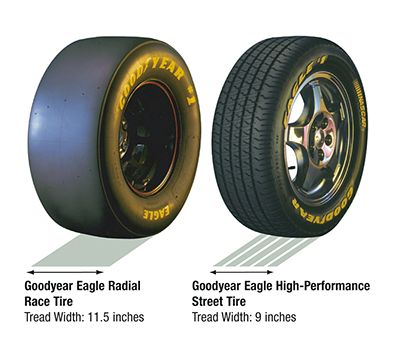I don't get to talk about racing enough, so I've created a new series where I'll get to do just that. Once a week (if time allows) I would like to talk about something that makes a race car far different from the one you drive all the time. A big one is aerodynamics. That, however, is my bread and butter, so I'll save it for later.
The first component I would like to talk about is inarguably the most important part for any automobile: the tires! Why are they the most important, you ask? It's the only part of the car that actually touches the ground!
At first glance. a race tire looks fairly similar to your ordinary road tire.
They couldn't be any more different, however. The most noticeable difference is the tread pattern. Typically, the tread of a race tire is slick, as shown above. This is to maximize the tire's contact patch with the ground, thereby maximizing grip. Many formula racing series do have rain tires for when it rains when they are running on road and street courses. This look much like a road tire in that there is a tread pattern rather than being slick. There are two different sets of rain tires, intermediates, and full wets. Intermediates are used when the track is wet, but little or no water is actually falling onto the track, whereas full wets are used when there is steady, consistent rain falling on the track. There are even more tread patterns for dirt tires, ice tires, etc. My specialty is formula racing, where neither of these are used, so I won't talk about them.
Many other differences come about due to the speed difference. Road tires are typically designed to maintain speeds up to 100 mph, where as a race tire has to endure speeds of over 200 mph! This means that the sidewall of the tire (the part where the manufacturer paints their logo) must be very sturdy so that the tire does not flex much. Speeds this high, as I'm sure you can imagine, lead to very high amounts of friction, and the tire starts heating up quite significantly, usually around temperatures where water begins to boil. To maintain the integrity of the tire and to keep it from blistering, the treads are incredibly thin, around the thickness of a credit card for slick tires (!!!). This temperature increase also means that the cold pressure of a racing tire is generally fairly low, around 20 psi where your car's tires have around 35 psi. Rain tires have much thicker treads and carry higher amounts of heat, but are cooled by the water on the track, so it is less of an issue. You typically want the temperature of the tire to be uniform, as this means that the entire surface of the tire was in contact with the road. If the middle of the tire is warmer than the edges, the tire is overinflated (and the other way around). Although for initial tests, it may be beneficial to overinflate the tire to see if the suspension needs tweaking to ensure an even contact patch (more on suspension at another point in time). You may have also noticed that pit crews seem to work effortlessly when changing tires, when you know your tires to be relatively heavy. It is not because the crew has superhuman strength, it is because the tire is so light!
Another thing to note is that the compound of the tire changes from track to track. Most tires are made of a synthetic rubber made from various chemicals, and the change in the recipe of the chemicals lead to a different end compound. These compounds change the overall "grippiness" of the tire. A tire with lots of grip is said to be "soft," and a tire with less grip is said to be "hard." There is a trade-off, however. Softer tires tend to degrade much quicker than hard tires, to you may only get a few laps of tire integrity before they start wearing away. (Yes, even race tires wear!)
I'm no expert on tires, and I'm sure there's far more that goes into them than even what I explained! I bet you never realized just how much goes on with something as mundane as tire. Race tire scientists and engineers certainly earn their income! I cannot remember the last time a Firestone failed in an IndyCar race.
Hopefully I'll get to keep doing these about once a week. Since I already alluded to it in this post, I'll probably talk about suspension next. Finals are next week, as well as checking residents out of the hall. It may be more like a week and a half, if not two weeks. If you have any questions, feel free to comment!

